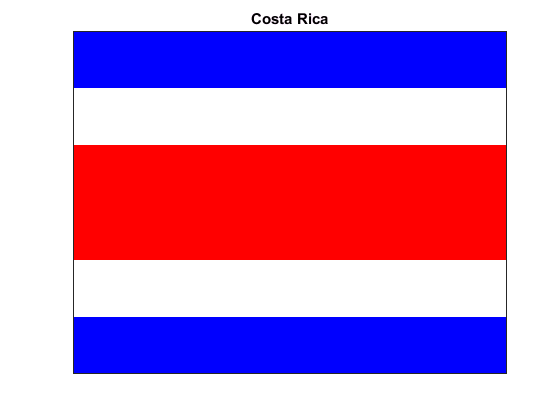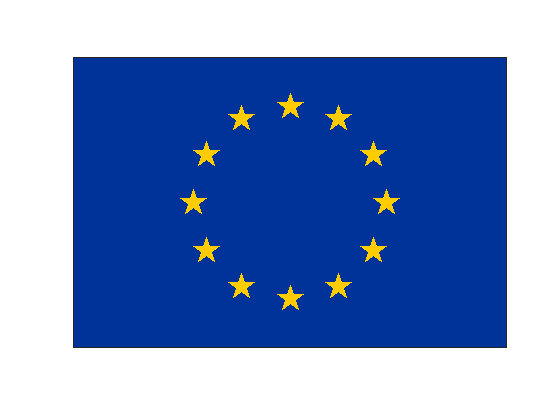Flag Math on Bastille Day
Let me start with a graphical riddle. In what sense is the following equivalence true?

To learn the answer, read on!
I recently came across Nick Higham’s fun post on one-liners in MATLAB. That piece and the approach of Bastille Day on July 14th made me think of another one-line program.
image([3 2 1]);colormap(flag)

Pretty impressive, considering that it’s only 29 characters long. Is this the shortest flag program we can write?
As I thought about flags and MATLAB, I gave myself the following task. Using only the colormap “flag” and images of vectors, how many national flags can we construct? Probably more than you might guess. Let’s go on a little tour.
Tidying Up the Flag
Proper flags shouldn’t have numbers running their edges, so I’d like to hide the tick marks and labels. Since I plan to do this multiple times in the script below, I’m going to use an anonymous function for compactness. It’s not necessary, but I like how it keeps the code tidy.
notick = @(ax) set(ax,'XTick',[],'YTick',[])
notick = @(ax)set(ax,'XTick',[],'YTick',[])
France
In honor of Bastille Day, we start with France.
france = [3 2 1]
france =
3 2 1
image(france)
title('Vive la France!')
notick(gca)

France is the only red, white, and blue tricolor with vertical bars. But if we look at horizontal patterns, we find many more.
Netherlands
Netherlands is a rotated version of France.
netherlands = rot90(france)
netherlands =
1
2
3
image(netherlands);
title('The Netherlands')
notick(gca)

Luxembourg
Luxembourg, next door to the Netherlands, uses essentially the same flag. A pedantic Luxembourger or professional vexillologist may protest that the colors are slightly lighter and the aspect ratio is slightly different. We will gloss over these details.
luxembourg = netherlands
luxembourg =
1
2
3
image(luxembourg)
title('Luxembourg')
notick(gca)

Thailand
thailand = [netherlands; flipud(netherlands)]
thailand =
1
2
3
3
2
1
image(thailand)
title('Thailand')
notick(gca)

Now we see the significance of the graphical riddle that we listed at the top of this post.
Russia
Russia’s flag is a variant on the three horizontal bands. We’ll use circshift to do a circular permutation of the colors in the Netherlands flag.
russia = circshift(netherlands,2)
russia =
2
3
1
image(russia)
title('Russia')
notick(gca)

Austria
austria = netherlands([1 2 1])
austria =
1
2
1
image(austria)
title('Austria')
notick(gca)

Indonesia
indonesia = netherlands(1:2)
indonesia =
1
2
image(indonesia)
title('Indonesia')
notick(gca)

Monaco
monaco = indonesia
monaco =
1
2
image(monaco);
title('Monaco')
notick(gca)

Poland
poland = flipud(monaco)
poland =
2
1
image(poland);
title('Poland')
notick(gca)

There you have it. A veritable Tour d’Image. I count nine separate vector flags using only red, white, or blue. Did I miss any?
As an exercise for the reader, express all flags in terms of the vector “france”.
Addendum #1: Costa Rica
In the comments, Matt Tearle points out another flag that fits the model. It’s a kind of dual to Thailand. I am now convinced that vexillology conventions should always occur in the Netherlands, its flag being the indispensable element at the center of all flag alchemy.
costarica = [flipud(netherlands); netherlands]
costarica =
3
2
1
1
2
3
image(costarica);
title('Costa Rica')
notick(gca)

Addendum #2
And Richard Alcock from MathWorks UK writes in to give us this timely and poignant example.
reflex_blue = [0 51 153]/255; yellow = [255 204 0]/255; [x, y] = pol2cart(linspace(0, 2*pi, 13), 1/3); plot(x, y, 'p', 'MarkerSize', 20, ... 'MarkerEdgeColor', yellow, 'MarkerFaceColor', yellow); axis('equal'); set(gca, 'Color', reflex_blue, ... 'XTick', [], 'YTick', [], ... 'Xlim', [-.75 .75], 'Ylim', [-.5, .5])

Addendum #3: Yemen
Sean de Wolski reminded me that black is one of the four colors of the “flag” colormap, thereby letting us add the Yemeni flag to our list. I thought the addition of black might give us a few more flags, but Yemen seems to be the end of it.
yemen = [1; 2; 4];
image(yemen)
title('Yemen')
notick(gca)

 Cleve’s Corner: Cleve Moler on Mathematics and Computing
Cleve’s Corner: Cleve Moler on Mathematics and Computing The MATLAB Blog
The MATLAB Blog Guy on Simulink
Guy on Simulink MATLAB Community
MATLAB Community Artificial Intelligence
Artificial Intelligence Developer Zone
Developer Zone Stuart’s MATLAB Videos
Stuart’s MATLAB Videos Behind the Headlines
Behind the Headlines File Exchange Pick of the Week
File Exchange Pick of the Week Hans on IoT
Hans on IoT Student Lounge
Student Lounge MATLAB ユーザーコミュニティー
MATLAB ユーザーコミュニティー Startups, Accelerators, & Entrepreneurs
Startups, Accelerators, & Entrepreneurs Autonomous Systems
Autonomous Systems Quantitative Finance
Quantitative Finance MATLAB Graphics and App Building
MATLAB Graphics and App Building








Comments
To leave a comment, please click here to sign in to your MathWorks Account or create a new one.